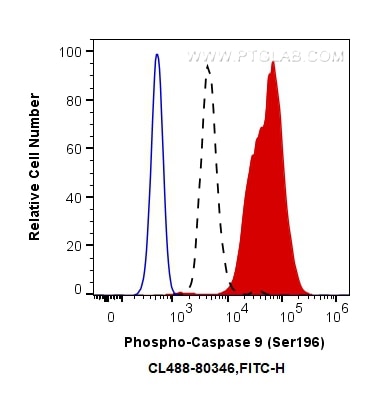Anticorps Recombinant de lapin anti-Phospho-Caspase 9 (Ser196)
Phospho-Caspase 9 (Ser196) Recombinant Antibody for FC (Intra)
Hôte / Isotype
Lapin / IgG
Réactivité testée
Humain, souris
Applications
FC (Intra)
Conjugaison
CoraLite® Plus 488 Fluorescent Dye
CloneNo.
3P16
N° de cat : CL488-80346
Synonymes
Galerie de données de validation
Applications testées
| Résultats positifs en FC (Intra) | cellules HEK-293 traitées à la calyculine A, |
Dilution recommandée
| Application | Dilution |
|---|---|
| Flow Cytometry (FC) (INTRA) | FC (INTRA) : 0.13 ug per 10^6 cells in a 100 µl suspension |
| It is recommended that this reagent should be titrated in each testing system to obtain optimal results. | |
| Sample-dependent, check data in validation data gallery | |
Informations sur le produit
CL488-80346 cible Phospho-Caspase 9 (Ser196) dans les applications de FC (Intra) et montre une réactivité avec des échantillons Humain, souris
| Réactivité | Humain, souris |
| Hôte / Isotype | Lapin / IgG |
| Clonalité | Recombinant |
| Type | Anticorps |
| Immunogène | Peptide |
| Nom complet | caspase 9, apoptosis-related cysteine peptidase |
| Masse moléculaire calculée | 46 kDa |
| Poids moléculaire observé | 46 kDa, 35 kDa |
| Numéro d’acquisition GenBank | BC002452 |
| Symbole du gène | Caspase 9 |
| Identification du gène (NCBI) | 842 |
| Conjugaison | CoraLite® Plus 488 Fluorescent Dye |
| Excitation/Emission maxima wavelengths | 493 nm / 522 nm |
| Forme | Liquide |
| Méthode de purification | Purification par protéine A |
| Tampon de stockage | PBS with 50% glycerol, 0.05% Proclin300, 0.5% BSA |
| Conditions de stockage | Stocker à -20 °C. Éviter toute exposition à la lumière. Stable pendant un an après l'expédition. L'aliquotage n'est pas nécessaire pour le stockage à -20oC Les 20ul contiennent 0,1% de BSA. |
Informations générales
Caspase 9 also name as MCH6, APAF3, APAF-3, ICE-LAP6 and CASPASE-9c, is a member of the cysteine-aspartic acid protease (caspase) family. It's synthesized as a 46kDa precursor protein which can be cleaved into a 35kDa subunit and a 11kDa subunit. The phosphorylated type can be detected at 55kDa and 35kDa. It plays a central role in the mitochondrial or intrinsic apoptotic pathway that is engaged in response to many apoptotic stimuli. Once activated, caspase-9 cleaves and activates the effector caspases 3 and 7 to bring about apoptosis. It can be phosphorylated by PKB/AKT1 at Ser196, this modification will downregulate its activity and decrease apoptosis. Akt phosphorylation site found in human caspase 9 is absent in mouse caspase 9.It's reported that there is an increase in caspase 9 expression and activity in the hypoxic brain. Inhibition of Caspase 9 activity would render opportunity to treat neurological diseases such as stroke, neurodegenerative diseases or brain injury caused by hypoxia. (PMID: 19788417, PMID: 10529400, PMID: 9812896, PMID: 18840507)


